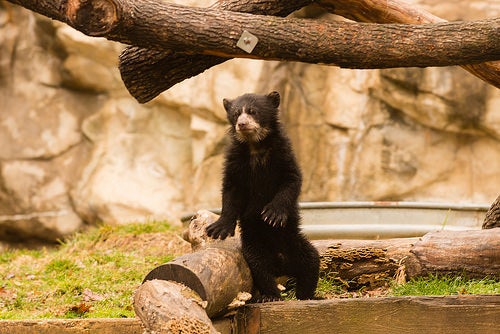Smithsonian's National Zoo Andean Bear Brothers Receive Names
The National Zoo's rambunctious and charismatic 19-week-old Andean bear cubs have names. In a poll conducted on the Zoo's website, fans elected to name Cub 1 Mayni [MY-nee], a moniker that in the Aymara language means "unique." The name selected for Cub 2 was Muniri [moo-NEE-ree], which means "loving" in the Quechua language. The family's public debut will take place Saturday, March 28, at 10 a.m., weather permitting.
In collaboration with Univision's ¡Despierta America!, the Zoo invited the public to cast their vote for names that reflected the cultural significance of Andean bears to the Quechua and Aymara, the indigenous communities of the Andes region, the native habitat of Andean bears. It is important for each cub to know its name now that keepers have started training sessions. They have spent the past few weeks teaching the bear brothers behaviors that will help animal care staff evaluate their health.
Since early March, the cubs have been acclimating to their yard and the variety of new smells, trees, rocks and other environmental enrichment in their yard. Keepers spread hay bedding around the yard to keep the cubs safe while they explore and play. Andean bears are very adept climbers, and the cubs have been testing out their skills. They will remain with Billie Jean for approximately one year.
The cubs were born at the Zoo Nov. 10 and 11, 2014, and are significant births for the population of Andean bears in human care. They are the third litter of cubs born at the Zoo since 2010, and one of only five surviving litters born in North American Zoos in the past 10 years. To follow the cubs' progress, check for news on the Zoo's website and its Facebook, Twitter and Instagram accounts.
Andean bears are South America's only bear species, and as their name suggests, they live in the Andes and outlying mountain ranges. Andean bears are listed as vulnerable on the International Union for Conservation of Nature's Red List of Threatened Species, and it is estimated that there are only 20,000 left in the wild. Habitat destruction and wildlife tracking pose the greatest threats to their survival.
The Smithsonian is bringing the cultural vibrancy, history and biodiversity of Peru and the Andean region of South America to the nation's capital. Through a series of programs, exhibits and events across the Smithsonian, visitors will learn about the rich history and achievements of indigenous communities, the importance of cultural continuity and traditions, and the conservation of biodiversity in the region.
# # #
Photo 1: Andean bear cub Mayni.
Photo 2: Andean bear cub Muniri.

